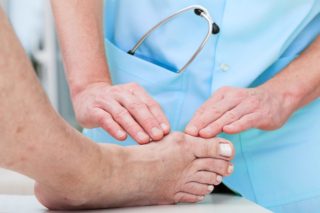 Bunions are a progressive disorder. They begin with a leaning of the big toe, gradually changing the angle of the bones over the years and slowly producing the increasingly prominent characteristic bump.
Bunions are a progressive disorder. They begin with a leaning of the big toe, gradually changing the angle of the bones over the years and slowly producing the increasingly prominent characteristic bump.
What Causes a Bunion?
Bunions are most often caused by an inherited faulty mechanical structure of the foot. It is not the bunion itself that is inherited but certain foot types that make a person prone to developing a bunion. Although wearing shoes that crowd the toes won’t actually cause bunions in the first place, it sometimes makes the deformity get progressively worse and may produce symptoms sooner.
Symptoms

Symptoms occur most often when wearing shoes that crowd the toes–shoes with a tight toe box or high heels. This may explain why women are more likely to have symptoms than men. In addition, spending long periods of time on your feet can aggravate the symptoms of bunions.
Symptoms, which occur at the site of the bunion, may include:
- Pain or soreness
- Inflammation and redness
- Burning
- Numbness
- Other conditions which may appear with bunions include calluses on the big toe, sores between the toes, an ingrown toenail, and restricted toe motion.
Diagnosis
Bunions are readily apparent–you can see the prominence at the base of the big toe or side of the foot. However, to fully evaluate your condition, the doctor may take x-rays to determine the degree of the deformity and assess the changes that have occurred.
Because bunions are progressive, they don’t go away and will usually get worse over time. But not all cases are alike–some bunions progress more rapidly than others.
